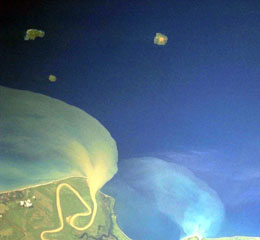Report on Kadovar (Papua New Guinea) — April 1977
Natural Science Event Bulletin, vol. 2, no. 4 (April 1977)
Managing Editor: David Squires.
Kadovar (Papua New Guinea) Thermal activity stabilizes
Please cite this report as:
Global Volcanism Program, 1977. Report on Kadovar (Papua New Guinea) (Squires, D., ed.). Natural Science Event Bulletin, 2:4. Smithsonian Institution. https://doi.org/10.5479/si.GVP.NSEB197704-251002
Kadovar
Papua New Guinea
3.608°S, 144.588°E; summit elev. 365 m
All times are local (unless otherwise noted)
"Since the previous report, five more ground inspections have been made, and a sixth is planned for the last week in April. Complete investigations, including temperature measurement, collection of gases and gas condensates, measurement of magnetic field, and seismic recording, were made during visits on 15-16 December (Cooke, Norris), and 16-18 February (Dent, Norris), and are planned for the forthcoming visit (Cooke, Norris). Partial investigations were made on 3 April (Wallace), when temperatures and gases were investigated, and on 26 January (Mahar) and 14 February (volcanological assistant J. Kuduon), when temperatures were measured. Vertical aerial photographs were taken by a survey firm on 15 November, and aerial obliques were taken during the December inspection. Another aerial inspection was carried out on 7 January, the day after a shallow M 6.5 earthquake about 30 km WSW of Kadovar on 6 January, 0611 GMT (preliminary location by USGS). This earthquake had no apparent affect on the volcano at the time.
"During the period covered by this report, the level of activity seemed to have stabilized. Maximum temperatures have been steady at 99-100°C, marked expansion of the main thermal area has ceased (although weak isolated gas vents are still occasionally found in new areas), and the quantity of gas emitted may even have declined slightly. The thermal area was not as unpleasant to the investigators as it was last November-December, although as some gas samples have not yet been analyzed quantitative information on the changing gas content is not available.
"No significant magnetic field changes have been detected. A few volcano-seismic events were recorded in both November and December, but such events appeared to be absent in February. Felt earthquakes were noted by inhabitants of nearby islands on several occasions, but there is no strong reason to associate these with Kadovar volcano. Unusually high seismic event counts on Kadovar are suspect because of a malfunctioning event counter.
"Although the initiation and early rapid development of this thermal activity led to the belief in a forthcoming Kadovar eruption, the stabilization (or even slight decline) in activity suggests the possibility that the event may be confined to thermal activity. Such purely thermal events have been reported elsewhere. However, the event will continue to be treated as a possible precursor to an eruption, and the former inhabitants will be advised to maintain the evacuation for the present. Only a small number of men are presently living on Kadovar in order to maintain the original gardens, to supply the evacuees on Blupblup Island. It is interesting to speculate that the 6 January earthquake may have been connected with the levelling-off of activity."
Geological Summary. The 2-km-wide island of Kadovar is the emergent summit of a Bismarck Sea stratovolcano of Holocene age. It is part of the Schouten Islands, and lies off the coast of New Guinea, about 25 km N of the mouth of the Sepik River. Prior to an eruption that began in 2018, a lava dome formed the high point of the andesitic volcano, filling an arcuate landslide scarp open to the south; submarine debris-avalanche deposits occur in that direction. Thick lava flows with columnar jointing forms low cliffs along the coast. The youthful island lacks fringing or offshore reefs. A period of heightened thermal phenomena took place in 1976. An eruption began in January 2018 that included lava effusion from vents at the summit and at the E coast.
Information Contacts: R. Cooke, RVO.

